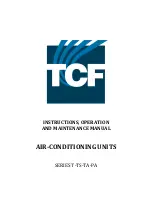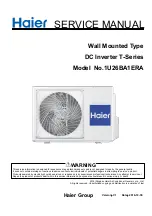
5
◆
When completing the flare connections, start the flare nuts by hand
;
then use the
two wrenches as described above to properly tighten.
◆
Refer to Table 1 below
if the torque setting is too high then the flare nut may be
damaged or the flare may crack causing leaks.
◆
Check all flare connections with soapy water or other leak detection method and if
no leaks are found
,
then insulate all connections with the proper insulating material as
shown in Fig.
5
below
.
Wrench
Thread fasten
er
(X4)
Ensure that the insulating
material is securely fastened to
the piping connections
Suction ling tubing
Liquid
line tubing
Insulating material
must cover the
piping completely
Insulating material
must cover the piping
completely
Flare nut
Torque wrench
Fig.
5
Table 1:
Torque settings for various sizes of flare connections
Diameter
(
Inch
)
Surface thickness
(
mm
)
Moment of torque (N
·
m)
φ1/4’’
≥
0.5
10-15
φ3/8’’
≥
0.71
25-32
φ1/2’’
≥
1
36-48
φ5/8’’
≥
1
51-62
φ3/4’’
≥
1
70-
86
If the specification of the outdoor unit pipe joint does not conform to that of the indoor unit, then
the joint specification of the outlet pipe of the indoor unit takes precedence. A reducing nipple
should
be installed at the joint of the outdoor unit so as to make the joint of the outdoor unit
compatible with that of the indoor unit.
2.7
Condensate
Hose
(1).
Condensate
hose
installation
◆
The diameter of the condensate hose should be equal to, or larger than, the unit's pipe
connection which is 1". (This will depend on the type of connection being used to join the two pipes.)
◆
Condensate
hose
should be installed with gravity fall and supported to prevent drainage
issues.
Summary of Contents for DHMW24NKB21S
Page 27: ...19 ...














































